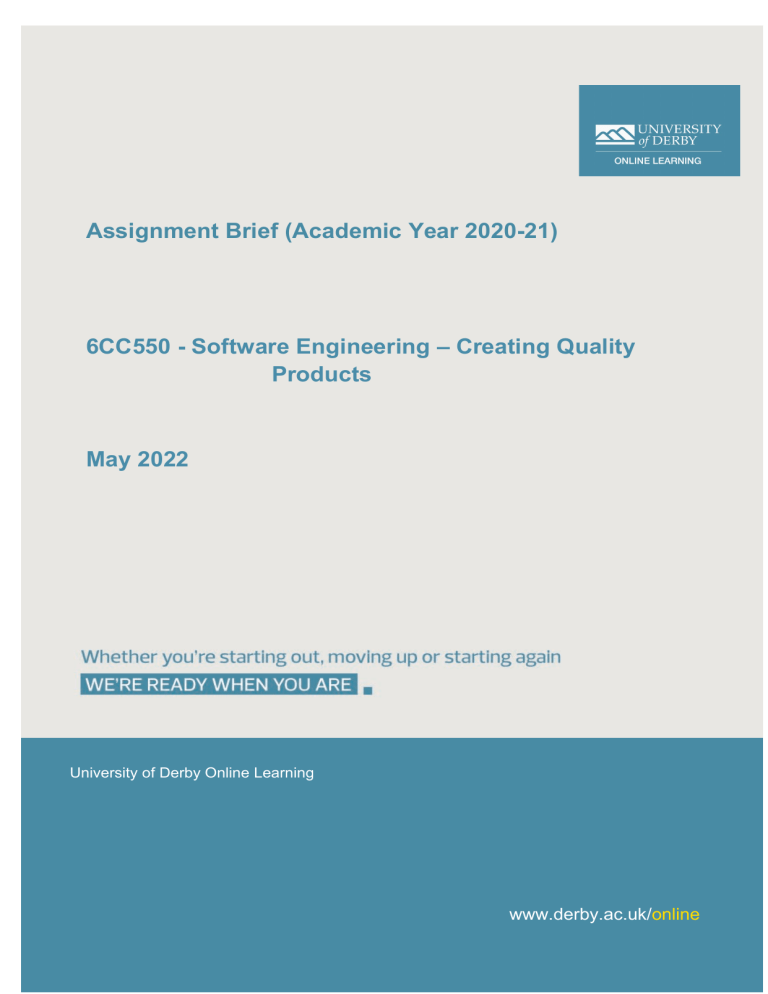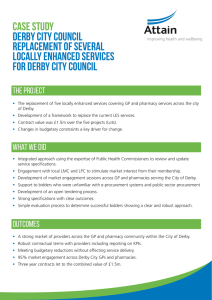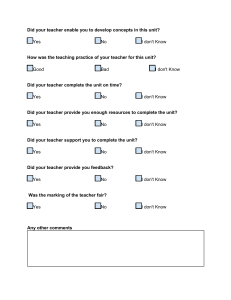
Assignment Brief (Academic Year 2020-21) 6CC550 - Software Engineering – Creating Quality Products May 2022 University of Derby Online Learning www.derby.ac.uk/online University of Derby Online Learning 1. Module Overview This module provides a wide-ranging and highly practical introduction to the Software Lifecycle – from software specification and design through to programming, testing and documentation. Basic programming techniques are introduced at an early stage and so previous programming experience is not assumed. However, those who have programming skills will gain the opportunity to extend their understanding of software development as an engineering process and to apply this knowledge in the implementation of a larger software development task. Practical programming is taught within a framework of software engineering techniques thereby allowing you to better appreciate that the ability to ‘cut code’ represents only one (albeit crucial) part of the software Life Cycle. Learners are introduced to a range of highly transferable skills which are needed in order to produce fully-documented high-quality software products. As part of the assessment for this module, you will design, develop, test and document several programmes. You may undertake this work individually or form a group (software development team). Groups normally comprise three members. Group work is strongly encouraged – but is not a requirement. 2. Learning Outcomes On successful completion of the module, you will be able to: 1. Demonstrate competence in basic algorithm design, program coding, documentation development, and debugging. 2. Apply software engineering techniques across key areas of the Software Lifecycle. 3. Critically appraise software development processes with particular reference to software specification, documentation and testing. NOTE: All class announcements and other emails relating to this module will be sent to the University of Derby email address that you have been given. You are expected to regularly check this email account (at least every 3 days). If you fail to do this, you will miss important information. Any emails that you send relating to this module must also be sent from your University of Derby email account. Within the title of any email that you send, you should include your name and the course code of this module Assessment Brief Template, Version 2, 0817 Page 2 of 17 University of Derby Online Learning 3. Assessment types used in this module Formative Assessment Formative assessments and activities are opportunities for you to apply, practice and make sense of the learning materials and content that you have worked with. These will mainly be located in the End of Unit Activities. We have written these to help you to (for example) practice some academic or professional skills, such as referencing, literature searching and analysing materials. You can choose how much time and effort you put into these activities. These may take the form of individual tasks, such as: reading some text, or watching a video and documenting your reaction to it; responding to some discussion points on the discussion forum; considering a case study; or, participating in a live online classroom session. The main aim of formative activities is for you to receive feedback on your contribution, performance, or progress that will help you prepare for and complete your final summative module assessment. All modules you take will vary in several ways, and the type of feedback you get for each formative assessment or activities will vary too. If your tutors give you marks as part of the feedback, these will not be counted in your final module grade. Summative Assessment Summative assessments are the pieces of coursework that you must complete which contribute towards your final grade in this module. If you have a Support Plan you can discuss with your module tutor what reasonable adjustments you need. Summative assessment in this particular module is via two pieces of submitted work. You will be expected to submit your summative assessments via Turnitin assessment points on the Assessment page in My Learning section of the module, or the Assessment Handler. You should take the feedback that you receive from the completion of summative assessments in this module and use it to help you improve your performance in future assessments. Assessment Brief Template, Version 2, 0817 Page 3 of 17 University of Derby Online Learning 4. Specific Assessment Component Guidelines Several parts of the assessment are based on a case study. The case study is introduced in the following section. Case study: Home Secretary The Beecham family lives in London and consists of 6 members; Mr and Mrs Beecham and their 4 kids; John is 26; Anna is 22, Thomas is 19 and Lisa is 15. Mr Beecham works as an airline pilot while Mrs Beecham works as a nurse. John is a software developer and works in Oxford, Anna and Thomas go to university in London and Lisa goes to school. All of them have smart phones with GPS but different operating systems including Android, iOS and Windows phone. They also have a list of their favourite shopping places with addresses that can be translated into GPS co-ordinates. Mrs Beecham and John own a smart car capable of connecting with the driver’s phone and internet as well. Beecham family house also has a smart fridge capable of sending and receiving Bluetooth notifications to connected devices. Beechams are very keen on having a closely knitted family life and always try to have a full house on family events. Mrs Beecham has a birthday next month, Anna is graduating in three months, John is getting married in six months and Lisa has an important football match next week she wants everybody to attend. They have to plan about when, where and how these events will be celebrated, who will attend and if the event requires planning and coordination, for example, John’s wedding, how will that coordination and planning be realised. They want to plan a surprise birthday party of Mrs. Beecham but it is proving difficult to organise the event without her getting to know. On top of that, a typical week in Beechams family involves groceries, maintaining garden, preparing bins for collection and cleaning. Currently, Anna complains that she has to do most of the chores and Lisa and Thomas don’t contribute enough, Lisa and Thomas disagree. They want fair distribution of workload between the resident family members but usually don’t find time to sit down with a paper and pen and assign tasks. Last week Mrs. Beecham placed an online order but still hasn’t been able to collect it due to lack of time and location of the collection. Last month, Anna was in a bit of a sticky situation since she completely forgot about John’s birthday and planned a night out with friends. She wishes that if her mother could have reminded her about it the situation could be avoided but Mrs. Beecham assumed she remembers. They both wish that if they had a way where somebody can create an event and add members to it which can then be visible on a common noticeboard it will be of help. Last night, they realised they are running short of eggs and decided that Mr. Beecham will pick the eggs up. Then during the day both Mrs. Beecham and Lisa were passing by different shopping stores and decided to get eggs, they both messaged Mr. Beecham to not bring eggs but still have twice the amount of eggs they need. If there was a way the person first getting eggs could mark the task as completed and the task is shared between group members then Mr. Beecham would know in advance that eggs have been bought. Assessment Brief Template, Version 2, 0817 Page 4 of 17 University of Derby Online Learning A few days before that, Mrs. Beecham made a shopping list of items to be purchased from their favourite store ABC, located between London and Oxford, when she came back John told her he was planning to come home this weekend and plans to stop by the store on his way over as he has to buy some stuff from that store. She thinks if only there was a way their individual lists could be automatically combined it would have saved one extra trip. Beechams are keen on planning a family holiday this year but with varying schedules and preferences it is proving too difficult for them to come up with dates, venues and travel plans. They wish if they could do it together with the constraints of being available at the same time and place it would be much easier. In their personal lives, they all use various scheduling and task management apps to keep track of their tasks and to-do lists. Considering the problems Beechams have been facing over scheduling and coordination they have tasked John to create a software application that can solve their problems. Assessment Brief Template, Version 2, 0817 Page 5 of 17 University of Derby Online Learning Coursework-1 Assessment description: Software Engineering and Programming Basics Assessment Component: Assessment weighting: Assessment limits: Assesses module learning outcome/s: 1 25% Last submission Date/Time: 2000 words 1, 3 Provisional feedback released: Thursday, July 07, 2022 by 2359 hrs (UK time) August 01, 2022 NOTE: As a student, it is your responsibility to adhere to the assessment limits (word count) as mentioned above. The module tutor will only mark the coursework that lies within the permitted assessment limits. You have to thoroughly study the project case study (Home Secretary) and formalise a software specification suitable for a Scrum managed project, - - Conduct a domain analysis for the problem domain (10%). o Ask questions if you have any regarding the requirements on the discussion forum thread setup for tutors to act as potential customers Build functional and non-functional requirements (40%). Perform a MoSCoW analysis on the functional requirements (10%). Build a list of, at least, five user stories (20%). Combine the analysis in the form of a document (20%). This part of the assessment aligns with the learning outcomes 1 and 3. Marking scheme 10%: Domain analysis. 40%: Functional and non-functional requirements. 10%: MoSCoW analysis of functional requirements. 20%: Preparation of user stories 20%: Presentation of the report Assessment Brief Template, Version 2, 0817 Page 6 of 17 University of Derby Online Learning Table 1: Sample outline for the requirement specification for component-1. Assessment Brief Template, Version 2, 0817 Page 7 of 17 University of Derby Online Learning Coursework-2 Assessment description: Software Project Development Assessment Component: Assessment weighting: Assessment limits: Assesses module learning outcome/s: 2 75% Last submission Date/Time: 3500 words. 2, 3 Provisional feedback released: Thursday, August 11, 2022 by 2359hrs (UK Time) September 05, 2022 NOTE: As a student, it is your responsibility to adhere to the assessment limits (word count) as mentioned above. The module tutor will only mark the coursework that lies within the permitted assessment limits. Coursework-2 comprises of two components which are referred to as component-1 and component-2. Component-1: 80% of the available marks This component of the assessment is online-based, self-paced and supported. It includes the following: • • • • • Detailed application of Scrum SDLC. 1. Management of Product Backlog. 2. Evidence of running sprints (at least 3). Application of software engineering techniques to a given problem statement. 1. UML design. 2. Product Backlog. Development of a test plan and test suite generation for each sprint. Development of prototype(s) to evaluate result of applying software engineering techniques on a problem statement. Demonstration video showing a working prototype. You will be asked to apply demonstrate your understanding of a number of key Software Engineering concepts. Based on the ‘Home secretary’ case study, some of the challenges of the application are, - Usable by people of all age groups with all types of technology experience. Should be accessible on multiple platforms. Should allow secure access and privacy of data. Assessment Brief Template, Version 2, 0817 Page 8 of 17 University of Derby Online Learning - - - Users should be allowed to create groups where friends and family can be invited to join. In a group everybody is allowed to create two types of events; occasions and tasks. o Events can be birthdays, funerals, weddings, graduations and so on. o Tasks can be shopping, cleaning, washing, pick/drop. o Tasks and events can be tracked in terms of progress, for example, 2/4 jobs completed for task-A or 65% of the jobs are completed. o Hint: You will have to establish what kind of data is required for these events. Once complete the events type tasks will show who completed it. The application will present a calendar view to the group with a list of tasks applicable to the person viewing it. So, if I am not involved in an event, I shouldn’t see it. The application should send reminders to event members, based on their profile settings. If I want to be reminded about Birthdays a week before the event I should get a notification week before. If the application is being accessed on a mobile phone some of the ideas are listed below, Figure 1: A sample sketch of how the application ‘may’ look like (a) A specific event interface (b) A collective interface for all events. Assessment Brief Template, Version 2, 0817 Page 9 of 17 University of Derby Online Learning Figure 2: A sample sketch of how the application ‘may’ look like (a) A job with a task, jobs can of different types (b) An active notification based on location. Component-1 Marking Scheme 20%: Evidence of application of an agile SDLC 20%: UML design & Product backlog creation 20%: Development of test suite for every iteration 30%: Development of prototype(s) 10%: Quality and completeness of the demonstration video. A sample outline for the software project report is shown below, Assessment Brief Template, Version 2, 0817 Page 10 of 17 University of Derby Online Learning Table 2: Sample outline for the project report for compoennt-2 in coursework-2 Component-2: 20% of the available marks. In this module you are expected to make regular and considered interactive contributions to the Discussion Board in the last 5 weeks of this module. In each unit of the module, you are provided with a number of discussion-based activities. Your mark for this component will be calculated on the basis of the Discussion Board postings that you make throughout the module. Consequently, during this period, you are required to copy at least 25 discussion board posting into your final coursework 2 submission document. For each of the postings, you should clearly state the date on which it was made. Guidelines 1. All postings must be written in a professional way. 2. Postings should be written in your own words. Copying and reproducing material from other sources and representing it as your own work constitutes plagiarism and is likely to result in the instigation of a formal Suspected Academic Offence process. 3. Following on from (2), you are encouraged to share with others in the class any relevant information that you locate when carrying out research into specific topics. This information may take the form of articles, website content, videos, etc. However, this content should add to your own discussion (rather than replacing it) and the source(s) of information must be clearly indicated. 4. You should endeavour to enter into interactive discussion and proffer help when questions are asked by others in the class. Assessment Brief Template, Version 2, 0817 Page 11 of 17 University of Derby Online Learning 5. The Discussion Board is intended to represent a dynamic virtual classroom in which you share your experiences, research, thoughts, etc. It is also an environment in which you are encouraged to ask and respond to questions. 6. Discussion Board postings such as ‘I agree’ (i.e. which do not move discussion forward) will not contribute to your grade for component-2 of coursework-2. 7. You are expected to demonstrate that you have regularly contributed to the Discussion Board and have meaningfully engaged in a number of activities. This means that you should frequently access the Discussion Board. 8. You are expected to demonstrate involvement in interactive discussion with other class members. 9. You are expected to demonstrate that you have undertaken research in developing postings. Component-2 Marking scheme 50%: Quality of postings. 25%: Regularity of postings. 25%: Engagement in interactive discussion Assessment Brief Template, Version 2, 0817 Page 12 of 17 University of Derby Online Learning 5. Feedback, marking criteria and grading of your assessment This section tells you how the marker will assess your work fairly. All markers aim for our feedback to be: timely, individual to you, helpful, empowering and manageable. They will also offer you opportunities to discuss the marking criteria they intend to use, and the type of feedback they intend to give you. You should create a shared understanding of this with them and your peers during the course of the module. They may also give you opportunities to assess your own work and the work of your peers. Look out for these opportunities. Assessment markers can give you feedback and allocate marks to you using a range of methods and tools that are appropriate to the specific module and assessment. The marker may make comments within your script (in bubbles) and may also give you written comments in the long box. They may give you a form of audio or video feedback. When they give you feedback on your assessment, as a minimum, your marker will tell you: • • • • if and how you have met the relevant learning outcomes the areas within which you did well in this assessment (they will commend you) the areas you could have improved in this assessment (they will make suggestions) what activities you can work on to help you in your next studies (you can take these ideas forward with you, and may discuss them with your Personal Tutor. You can also build them into your Action Planning. In this module specifically, they will use the following tools. This feedback and marking structure will be specific to each component as relevant. This module uses a grading scale applicable to Level 6 in the University Credit Framework. The grade descriptors given below are typical characteristics of the standard of work associated with each grade. Mark Descriptors 70-100% Excellent Outstanding detail and professionalism in report writing, application of software engineering practises to software development, excellent video demonstration. Comprehensive requirements specification, testing and UML design. All requirements completely met. (90-100%) Depth of analysis, application development and video presentation above and beyond the listed requirements. Consistent and useful contributions to the discussion boards. Very Good Most requirements are met, prototype meets most functional requirements and there is significant evidence of applying software engineering principles. Good use of UML models and project management principles. Report shows evidence of further reading, detailed research and analysis. Consistent contributions to the discussion boards. Assessment Brief Template, Version 2, 0817 Second Div 1 60-69% Class First % Page 13 of 17 University of Derby Online Learning Around half of the project requirements are met, prototype meets at least half of the functional requirements and there is good evidence of application of iterative software development and design principle. Good use of UML models and project management principles. Report shows some evidence of further reading, research and analysis. Regular contributions to the discussion boards. Satisfactory Less than half of the project requirements are met, prototype meets only few of the functional requirements and there is little evidence of application of iterative software development and design principle. UML modelling is not comprehensive and project management principles are not applied. Report shows little evidence of further reading but none for research and analysis. Contributions to the discussion boards and very generic and lack critical thinking. 35-39% Unsatisfactory Very few requirements met. Report is incomplete. Design is non-existent. UML modelling and requirements analysis is insufficient. Video doesn’t show a working prototype. 21-34% Third 40-49% Second Div 2 Good Marginal Fail 50-59% Poor Little evidence of application of any software design and engineering principles. Report lacks both structure and content. Report is mostly incomplete and limited. Video is very poor, shows no working prototype and is poorly recorded or inaccessible. Code written is very limited, not commented or structured. Very Poor No requirements are met. Report is poorly written and structured. Lacks critical analysis and use of references. Design is incorrect or non-existent. Video is unacceptable or non-existent. Code is insufficient, poorly structured and doesn’t work. NS Fail 1-20% Non-submission No work has been submitted. Z Academic offence notation Applies to proven instances academic offence. Assessment Brief Template, Version 2, 0817 Page 14 of 17 University of Derby Online Learning 6. Assessment Presentation When marking this assessment, the markers will also be looking for the following. Legible presentation. Good use of spelling, grammar and language throughout. Appropriate focus, meeting learning outcomes/assessment criteria. Logical progression and structure of arguments. Evidence of a range of relevant supporting reading. Use of accurate, evidence-based information to support the arguments made. Follow normal Academic Regulations in terms of Academic Offences, style and language. Use of the appropriate system of referencing and may include a bibliography that lists all resources referenced. A declaration statement which says you have checked your Turnitin originality report and that you are certain that the work is your own (and has never been submitted for marking before by you, or anyone else). A statement that says you have maintained the confidentiality of clients/customers and persons associated with them, including colleagues and organisations. Key objectives in developing your video presentation should be to: Clearly explain the work undertaken. Employ an interesting and lively style of presentation. Avoid simply reading from a prepared script. You will note that most of these will have been incorporated within the marking criteria (on the previous page) and marks will have been allocated to them. Different modules will give different priority to these. Table 1 shows a summary of what type and form of deliverables are required for different parts of the assessment. Coursework Component Deliverable Details Coursework-1 Component-1 Word/PDF Single Microsoft document. document Word or PDF Component-1 Word/PDF document Single Microsoft Word or PDF document. An outline for the document is shown in Table 2. Component-2 Word/PDF document This is based on your contributions to the discussion board. Coursework-2 Table 3: Details of deliverable required to be submitted for assessment. Assessment Brief Template, Version 2, 0817 Page 15 of 17 University of Derby Online Learning 7. Assessment regulations The standard University assessment regulations apply for this assessment. Please note that in line with the University common assessment regulations, failure to submit coursework (i.e. non-submission) could lead to you failing the module. Details of assessment regulations are available at: https://www.derby.ac.uk/about/organisation/academic-regulations/ (sections F and E). Work Submitted late, will be marked according to University regulation, please see the University guidance on Late Submissions. Assessment Brief Template, Version 2, 0817 Page 16 of 17 University of Derby Online Learning 8. Where to get other help to do your assessment During the course of the module your tutor will offer you a range of help and support. There are contact details for them within the module. Other colleagues will offer help and guidance on the Student Portal. In addition, the Academic Administrators will post helpful notices on your module announcement board. You could also use the following links if you want extra help with: Referencing and avoiding making an academic offence Study Skills Assessment Brief Template, Version 2, 0817 Page 17 of 17




